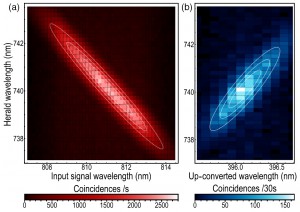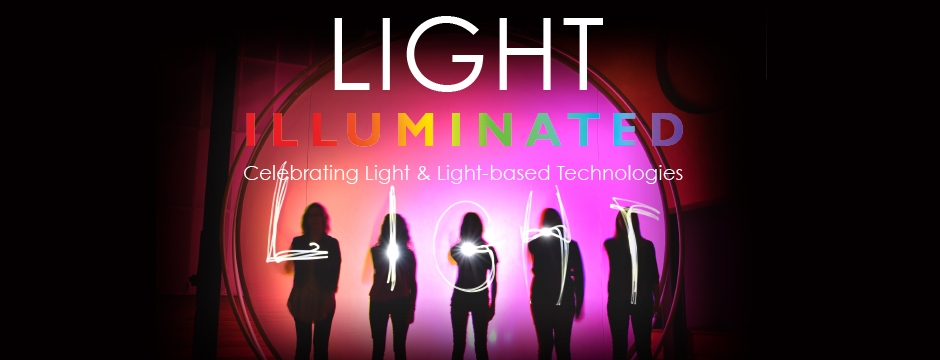Introduction We are an experimental quantum optics group run by Kevin Resch, based in the Department of Physics & Astronomy and the Institute for Quantum Computing at the University of Waterloo.
|
Our article, Observation of Genuine Three-photon Interference, by Sascha Agne, Thomas Kauten, Jeongwan Jin, Evan Meyer-Scott, Jeff Z. Salvail, Deny R. Hamel, Kevin J. Resch, Gregor Weihs, and Thomas Jennewein was published in Physical Review Letters. This work was a collaboration between groups at IQC and the University of Innsbruck. The paper was discussed as a Viewpoint in Physics, Photonic Hat Trick, by Robert Sewell and was also selected as a Editor’s Suggestion.
Abstract: Multiparticle quantum interference is critical for our understanding and exploitation of quantum information, and for fundamental tests of quantum mechanics. A remarkable example of multi-partite correlations is exhibited by the Greenberger-Horne-Zeilinger (GHZ) state. In a GHZ state, three particles are correlated while no pairwise correlation is found. The manifestation of these strong correlations in an interferometric setting has been studied theoretically since 1990 but no three-photon GHZ interferometer has been realized experimentally. Here we demonstrate three-photon interference that does not originate from two-photon or single photon interference. We observe phase-dependent variation of three-photon coincidences with (92.7±4.6)% visibility in a generalized Franson interferometer using energy-time entangled photon triplets. The demonstration of these strong correlations in an interferometric setting provides new avenues for multiphoton interferometry, fundamental tests of quantum mechanics, and quantum information applications in higher dimensions.
Our paper, Spectrally Engineering Photonic Entanglement with a Time Lens, by John Donohue, Morgan Mastrovich, and Kevin Resch was published in Physical Review Letters. The PRL paper can be found here and a preprint is on the arXiv.
Abstract: A time lens, which can be used to reshape the spectral and temporal properties of light, requires the ultrafast manipulation of optical signals and presents a significant challenge for single-photon application. In this work, we construct a time lens based on dispersion and sum-frequency generation to spectrally engineer single photons from an entangled pair. The strong frequency anticorrelations between photons produced from spontaneous parametric down-conversion are converted to positive correlations after the time lens, consistent with a negative-magnification system. The temporal imaging of single photons enables new techniques for time-frequency quantum state engineering.

Morgan Mastrovich has joined the group as an MSc candidate and wasted no time in publishing her first paper with us – Welcome Morgan!
John Donohue successfully defended his PhD thesis, Ultrafast manipulation of single photons using dispersion and sum-frequency generation. Congratulations Dr John!
Kent Fisher successfully defended his PhD thesis, Photons & Phonons: A room-temperature diamond quantum memory. Congratulations Dr Kent!
In other news:
…Morgan won a Mike and Ophelia Lazaridis Scholarship
…Kent was awarded an NSERC PDF and an IQC achievement award
…Jean Philippe MacLean was awarded the IQC David Johnston Award for Scientific Outreach
Update Feb 13, 2017: Congratulations to Mike Mazurek for being selected for an IQC achievement award for his work on noncontextuality tests
Our paper, Phonon-Mediated Nonclassical Interference in Diamond, by Duncan England, Kent Fisher, Jean-Philippe MacLean, Philip Bustard, Khabat Heshami, Kevin Resch, and Benjamin Sussman was published in Physical Review Letters. This work is the result of a collaboration with Ben Sussman’s Quantum Technologies Laboratory at the National Research Council Canada.
Abstract: Quantum interference of single photons is a fundamental aspect of many photonic quantum processing and communication protocols. Interference requires that the multiple pathways through an interferometer be temporally indistinguishable to within the coherence time of the photon. In this Letter, we use a diamond quantum memory to demonstrate interference between quantum pathways, initially temporally separated by many multiples of the optical coherence time. The quantum memory can be viewed as a light-matter beam splitter, mapping a THz-bandwidth single photon to a variable superposition of the output optical mode and stored phononic mode. Because the memory acts both as a beam splitter and as a buffer, the relevant coherence time for interference is not that of the photon, but rather that of the memory. We use this mechanism to demonstrate nonclassical single-photon and two-photon interference between quantum pathways initially separated by several picoseconds, even though the duration of the photons themselves is just ∼250 fs.
Our article, An experimental test of noncontextuality without unphysical idealizations, by Mike Mazurek, Matt Pusey, Ravi Kunjwal, Kevin Resch, and Rob Spekkens was just published in Nature Communications. This work is the result of a collaboration between IQC and the Perimeter Institute on Experimental Quantum Foundations.
Abstract: To make precise the sense in which nature fails to respect classical physics, one requires a formal notion of classicality. Ideally, such a notion should be defined operationally, so that it can be subject to direct experimental test, and it should be applicable in a wide variety of experimental scenarios so that it can cover the breadth of phenomena thought to defy classical understanding. Bell’s notion of local causality fulfils the first criterion but not the second. The notion of noncontextuality fulfils the second criterion, but it is a long-standing question whether it can be made to fulfil the first. Previous attempts to test noncontextuality have all assumed idealizations that real experiments cannot achieve, namely noiseless measurements and exact operational equivalences. Here we show how to devise tests that are free of these idealizations. We perform a photonic implementation of one such test, ruling out noncontextual models with high confidence.
Patrick Daley has joined us for the summer from McMaster University to work in the group and attend the USEQIP summer school. Welcome Patrick!
Our new article Frequency and bandwidth conversion of single photons in a room-temperature diamond quantum memory by K.A.G. Fisher, D.G. England, J.-P.W. MacLean, P.J. Bustard, K.J. Resch, and B.J. Sussman was published in Nature Communications. The work is the result of our collaboration with Ben Sussman’s Quantum Technology group at the National Research Council of Canada.
Abstract: The spectral manipulation of photons is essential for linking components in a quantum network. Large frequency shifts are needed for conversion between optical and telecommunication frequencies, while smaller shifts are useful for frequency-multiplexing quantum systems, in the same way that wavelength division multiplexing is used in classical communications. Here we demonstrate frequency and bandwidth conversion of single photons in a room-temperature diamond quantum memory. Heralded 723.5 nm photons, with 4.1 nm bandwidth, are stored as optical phonons in the diamond via a Raman transition. Upon retrieval from the diamond memory, the spectral shape of the photons is determined by a tunable read pulse through the reverse Raman transition. We report central frequency tunability over 4.2 times the input bandwidth, and bandwidth modulation between 0.5 and 1.9 times the input bandwidth. Our results demonstrate the potential for diamond, and Raman memories in general, as an integrated platform for photon storage and spectral conversion.
See also a write-up on our work:
Changing the colour of single photons in a diamond quantum memory, phys.org
Thank you Minister Duncan!
Our article, Experimental nonlocal and surreal Bohmian trajectories, by D. H. Mahler, L. Rozema, K. Fisher, L. Vermeyden, K.J. Resch, H.M. Wiseman, and A. Steinberg was published in Science Advances. The work is the result of a collaboration between the University of Toronto, Griffith University, and University of Waterloo.
Abstract: Weak measurement allows one to empirically determine a set of average trajectories for an ensemble of quantum particles. However, when two particles are entangled, the trajectories of the first particle can depend nonlocally on the position of the second particle. Moreover, the theory describing these trajectories, called Bohmian mechanics, predicts trajectories that were at first deemed “surreal” when the second particle is used to probe the position of the first particle. We entangle two photons and determine a set of Bohmian trajectories for one of them using weak measurements and postselection. We show that the trajectories seem surreal only if one ignores their manifest nonlocality.
See also:
Realism is for people who can’t handle their nonlocality by A. Steinberg.
(Here is a link to the paper by Braverman and Simon referred to in the article as ‘further reading’)
Researchers demonstrate ‘quantum surrealism’ on Phys.org.
Quantum weirdness may hide an orderly reality after all on NewScientist.com
Our article, Certifying the Presence of a Photonic Qubit by Splitting It in Two, by Evan Meyer-Scott, Daniel McCloskey, Klaudia Gołos, Jeff Z. Salvail, Kent A. G. Fisher, Deny R. Hamel, Adán Cabello, Kevin J. Resch, and Thomas Jennewein just appeared in Physical Review Letters. The paper was chosen as an Editors’ Suggestion.
Abstract: We present an implementation of photonic qubit precertification that performs the delicate task of detecting the presence of a flying photon without destroying its qubit state, allowing loss-sensitive quantum cryptography and tests of nonlocality even over long distance. By splitting an incoming single photon in two via parametric down-conversion, we herald the photon’s arrival from an independent photon source while preserving its quantum information with up to (92.3±0.6)% fidelity. With reduced detector dark counts, precertification will be immediately useful in quantum communication.
Congratulations to Ian, Kent, Aimee, Sarah, Jean-Philippe, and Mike for their contribution to the exhibition ‘Light Illuminated: Celebrating Light & Light-based Technologies‘ at THEMUSEUM in Kitchener as part of the UN 2015 International Year of Light. The exhibit effectively, interactively, and accessibly describes the physical aspects of light such as polarization, interference, and the speed of light; light-based technologies such as fibre optics, thermal imaging; and applications such as the laser maze (my kids’ favourite), an infinity mirror, 3D orientation recognition and optical ‘painting’. The exhibition is on until March 28, 2016.

|
|


